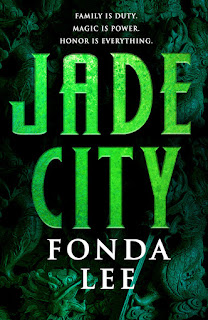 |
| Image from http://fondalee.com/books/jade-city/ |
Fonda Lee (maps by Tim Paul)
Orbit, 7 November 2017
HB, 498pp
I'm grateful to Orbit for an advance copy of this book.
Jade City is an extremely readable, smart - and violent - account of life and street power. The setting might, I'd guess, be somewhere, in South East Asia based on the historical background (military occupation some decades ago; a liberation struggle during the "Many Nations War"), culture and atmosphere but the country names, politics and religion make clear that this is a fantasy world. Not being set in another retread vaguely Northern Europe fantasy kingdom gave it all a distinct freshness. Every detail (the names of cars, models of sub-machine guns, foods) of the intricate, convincing worldbuilding adds something and - since there's a lot of this book - Fonda Lee has the space to do it properly, digressing to give us religious myths, fragments of the history of Kekon, the island where the story takes places, and information about the codes of the families who run the city of Janloon. The map of Janloon itself is a marvel - it could have come straight out a Rough Guide.
It's not only the little things, but the power structures here convince. Take those families. "Family" is a good word, isn't it? Families are warm, nurturing places to be. But the word can have other connotations. As the cover proclaims
Family is Duty.
Magic is power.
Honour is Everything.
If that (barring the magic) reminds you of, say The Godfather or perhaps of Dune, you aren't far wrong. At the heart of Jade City is a struggle between rival families for control of the city. It's not a pretty sire, but makes for a captivating read with real tension. In its intricate plots, manoeuvrings, betrayals and - above all - outbreaks of bloody slaughter, the book has an irresistible dynamism, a sort of tragic momentum. We know it's going to end badly but we still watch enthralled as each move and counter-move plays out. Yes, I know that sounds as though it's a film, not a book: it's a very visual book, OK?
Two noble families, alike in dignity, former allies in the struggle for national freedom, descended to the level of mobsters, carving up the city between them, accommodated by a weak and corrupt political class. They were The Mountain, and No Peak. We see the story mainly from the perspective of No Peak, a clan whose aged boss is sinking into senility. The grandson, Lal, is the new Pillar of the Clan; his brother Hilo is the Horn, the military leader, while sister, Shae, groomed to manage the business side as Weather Man, is absent, having rejected the life and left to study in foreign Espenia. The tensions and history between these three will drive much of the action: Lee has provided a triplet of deeply believable, flawed yet human characters and shows is enough of their history to show just where they're coming from, and likely to end up.
It's not only these three who convince. Almost everyone in the book, you might meet on the street or in a bar (though you probably wouldn't want to). In particular there's Anden, the adopted sone of the clan who's at the Academy honing his magical abilities but whose internal conflict - where does he belong? Does he really want to wield the jade? Can he handle it? - is key here
One might almost include the jade itself as a character. How to explain the jade? "Bioenergetic jade", it's described as in one place - by an outsider - and it only exists on Kekon. A focus for power, addictive to those who are sensitive, it can consume its users, enabling the six forms of magic used by the Green Bones, adepts who have learned to control it. (In passing, the author has designed a lovely way of referring to these powers. A character will "jump Lightly" or a bullet will "meet her Steel" meaning that she's used the ability to become nearly weightless, or to deploy an impenetrable barrier against missiles).
When a Green Bones is killed by another, the victor takes the loser's jade. The more you wear, the more dangerous you are - and the more danger you're in. Trade in the gemstones is lucrative, a faultline for clan rivalries (alongside more traditional mob businesses such as gambling or girls). Jade is central to the history, moral system and religion of the Kekonese people - and those who don't have it, like young hoodlum Bero, can hunger for it almost to the point of madness.
With jade, Fonda Lee delivers, I think, a metaphor for corruption, temptation and hunger for power such as I've seldom seem before. Perhaps, as I hinted above, the place of spice in the Dune books is similar, though less extreme: jade is much less a commodity, much more a way of life. It's hard to overstate its importance to the lives of these characters: whether they reject it, like Shae, or want more, like Bero, it's jade that rules here, whatever clan you belong to. Do what you will - dress it up in codes of honour, limit the quantities available as the KJA cartel tries to do, or train yourself to master it - you'll end at the same place.
Even as a reader, I'm hungry for more jade - this book stops at a natural pause in the war that has broken out, but it's not over; "a Mountain is not easily pushed into the sea", we read towards the end. I'm eagerly looking forward to more corruption, violence, good intentions gone awry, and honour bleeding out on the streets of Janloon.
No comments:
Post a Comment